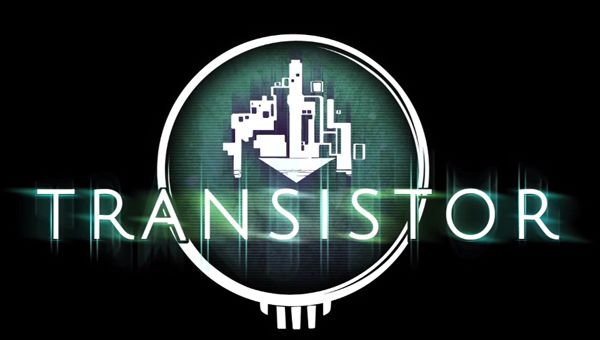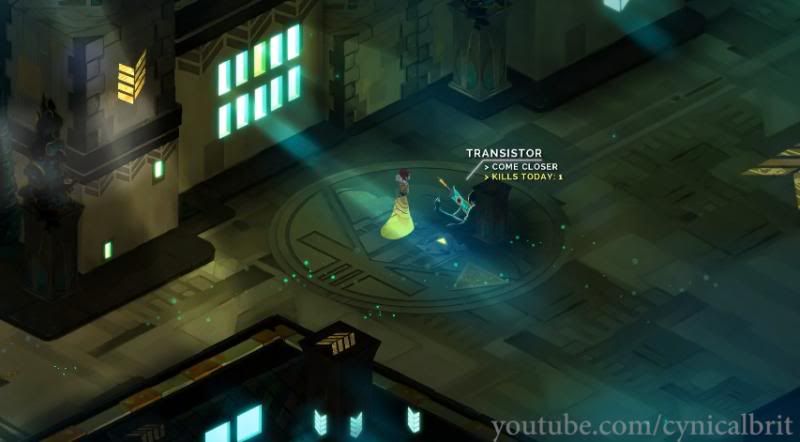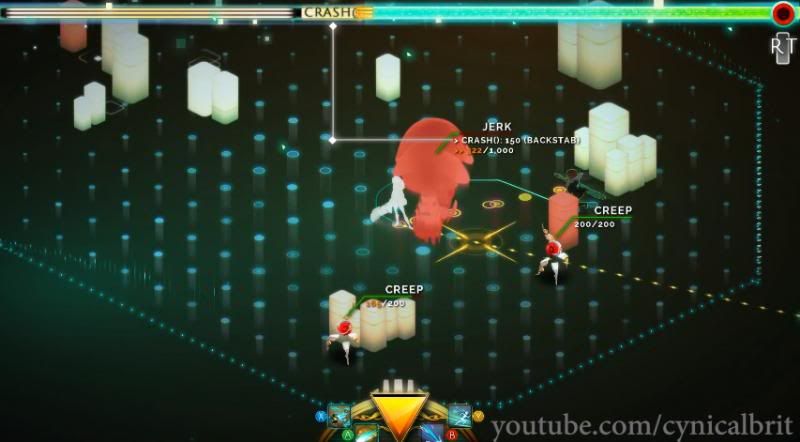
It’s been almost a year since I did my writeup for Bastion. It’s proof positive that game developers with fresh ideas and stories to tell don’t need to hitch themselves to the wagon of any particular publisher. If I recall correctly from TotalBiscuit’s interview with Supergiant Games’ creative director Greg Kasavin, that little game sold 1.7 million copies. I, along with many others, have been wondering what would come next from this charming studio. That question was answered at PAX East 2013: Transistor.

There it is.
They teased us before the event with a trailer, which you can see here. Their booth was set up with images both familiar and new: Rucks, Zulf, and Zia from Bastion on banners that partially concealed the images of the flame-haired woman with the odd weapon that apparently gives the new title its name. The line was long, but the wait is worth it. Even though the demo only ran about 15 minutes, it highlighted the crux of the gameplay, introduced a fascinating new world, and whets the player’s whistle for more; in other words, it’s a demo that kicks ass for a game that looks to be every bit as good as Bastion if not better.
While the game does introduce us to an isometric view of a silent protagonist smashing things with what appears to be a rather nasty blunt weapon, the world is not the empty post-Calamity landscape of Caelondia, but the lively city of Cloudbank that might actually be in the process of a Calamity of some kind. Mechanical menaces that vaguely resemble refugees from Aperture Science (white hulls, red camera eyes, etc) appear to be reformatting the city and removing people that can stop them. On their list was our heroine, Red, and while they stole her voice, they didn’t quite finish the job, and she’s left with the Transistor, a unique and powerful weapon that speaks with a voice from beyond the grave.

Execute Turn()
The Transistor also seems to interrupt the processes of things around Red, including time itself. It changes what appears at first to be an isometric bash-em-up to a thought-provoking tactical game that rewards careful planning and mixing strategies. The thinking behind the construction of the UI and skill set is that the Transistor is already the most powerful weapon available; rather than entice us to play more with new weapons to unlock, different abilities look to allow the player to vary their playstyle to their liking rather than being stuck with bashing away. The enemies, as well, vary in how they approach Red, from duplicating teleporters to big burly jerks that destroy what little cover you can find. All of this is conveyed in the high-quality art style of Supergiant Games, and Logan Cunningham lends his voice to Red’s unique weapon.
Instead of simply a sequel or retread of Bastion, however, Transistor is already carving out its own niche. It feels decidedly more science fiction than Bastion’s fantasy adventure. The music has a more electronic bent to it, as well as being more feminine in its voice, while every bit as haunting and memorable as the soundtrack of the previous game. Red seems to have a bit more agency than the Kid, and the voice of the Transistor is very different from the voice of Rucks: less seasoned, more nervous and desperate, an immediate in-the-moment character rather than a reflective old man. Put it all together, and you have a game that, while familiar in many ways, promises a new story with which to fall in love coupled with gameplay that will challenge you, spark your imagination, and make the points of said story all the more rewarding.
And I, for one, can’t wait to play it.
You can see Transistor‘s early build in action over at CynicalBrit, both with and without commentary.







